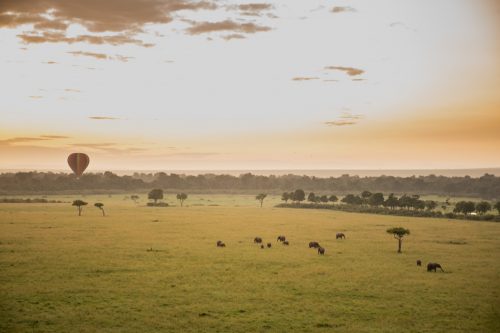Eight female lions comprise the Maji Machafu Pride under the territory of the four dominant Inselberg males. While the brothers were some distance away, busy with a hippo kill, the females enjoyed their own impressive kill. We found six of the eight, accompanied by six cubs — five young and one slightly older — feasting on a buffalo. This remarkable hunt, requiring strength and coordination from all the females, showcases their skill and teamwork. Unfortunately, one female was limping badly, likely injured during the intense effort to bring down the buffalo.
The curious and playful cubs climbed atop the once formidable and imposing buffalo, a creature symbolising both strength and danger. Their tiny frames, barely larger than the buffalo's massive head, revelled in the feast under the protective gaze of their mothers, blissfully unaware of the challenges ahead. One day, these cubs will mature into the Pride's providers, facing the relentless trials of survival in the wild.
Two days later, after the Inselberg males had gotten wind of the kill, there was barely anything left. Vultures circled while Ginger and the injured female protected the now foul carcass. By now, blowflies had completely infested it, laying eggs to hatch into maggots that consume soft tissues. Bacteria and fungi become the primary decomposers, breaking down remaining tissues into simpler organic compounds.
Of the only two species of ground hornbill, the southern ground hornbill is the largest and is found exclusively in Africa. These birds have a very low reproductive rate, with females laying just one to three eggs. Only the first chick to hatch is usually raised, as the others die from neglect or starvation. After hatching, a chick will remain in the nest for about three months, depending on its parents for food and care.
Maturity also takes a very long time compared to other bird species, which can be indicated by their iconic red facial and throat colouration when they mature. As juveniles, this is a dull pale colour and only starts to develop between four and six years of age as they approach sexual maturity. Ground hornbills may live for 40-50 years; the oldest recorded was over 60.
Herbivores' diets mainly consist of leaves, flowers, and fruits, but these plant-based foods may not always provide enough minerals, especially in areas deficient in soil nutrients. As a result, one may encounter a herbivore like this giraffe chewing on bones, a behaviour called osteophagy. A unique adaptation, bone chewing is a way to maintain their calcium and phosphorus nutritional balance.
The rains are here, transforming the landscape into a lush, green paradise. The dust has settled, the ground has soaked, and the afternoon clouds hang heavy above the savannah. The crisp, clean air during drives is absolutely invigorating, and the wildlife sightings remain exceptional.
When it rains in the savannah, the conditions become more favourable for birds, bringing an influx of hamerkops, lilac-breasted rollers, hawks, the pin-tailed whydah, and more. Rain creates puddles and ponds, providing access to water for drinking and bathing. It also causes the growth of vegetation and an explosion of insects, providing birds with abundant food. —Robert Sayialel
This week, the Guides hung up their safari boots for a well-deserved break after an action-packed year of back-to-back safari drives and a healthy dose of training sessions to refresh their skills. But don’t worry — they’re just recharging their batteries and will return next week, ready for more adventures.
Of course, the animals are still around. Craig was seen grazing in Kimana Sanctuary, and we're hoping he's making himself right at home at Angama Amboseli.
Filed under: This Week at Angama
Subscribe for Weekly Stories
Comments (0):

Hot-air Ballooning